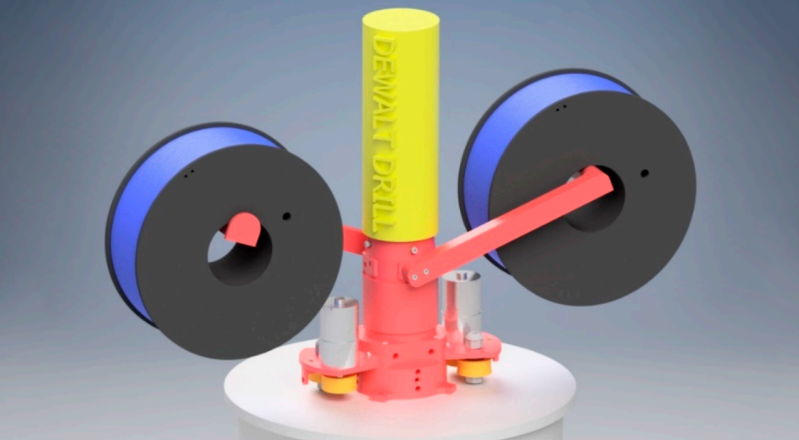The ABS and PLA that goes into your 3D printer is sold in two forms. The first, naturally, is filament. The second is plastic granules, the raw material for your filament, and costs an order of magnitude less than the filament itself. For years we’ve been seeing machines that either print directly with plastic granules or are converted into filament with fancy filament-extruding machines. Now we can do it the other way. [Aubrey Woern] and [Joshua Pearce] of Michigan Tech have been working on a polymer pelletizer chopper that takes plastic filament and turns it into pellets.
The system uses a large corded drill motor to drive a Forstner drill bit. Filament is then threaded into the top of this spinning drill bit with the help of a small DC motor and grippy wheel printed out of Ninjaflex. The system works, and the authors of the paper were able to vary the size of the chopped filament by feeding it into the Forstner bit faster or slower.
While turning an expensive product (filament) back into its raw material (pellets) may not seem like a great idea, there have been a significant number of advancements in the state of manufacturing filament on a desktop and printing directly from pellets in recent years. A machine that turns plastic back into its raw state is something that’s needed if you want to experiment with plastic recycling, and this machine is more than capable of chopping up a spool of filament in two hours or so.
















Mind -> Blown…
Mine too but only because I read the headline then the first line and did a double take of the headline to make sure I did not read it backwards… Nope.
Well, I could see it being used to mix two different colors of filament into a new color or mottled.
If you read the paper, they demo exactly this, mixing white and brown pellets of different sizes, and feeding them into a hopper to extrude new filament.
Perhaps another use for the blender folks? Novel bit of time killer if you’ve never stumbled across these videos.
https://www.youtube.com/user/Blendtec/videos?disable_polymer=1
I wonder if filament that has turned too brittle to print might be usable as pellets.
I was thinking the same thing. Not to mention when you bake filament to reduce the moisture content, if there was a large amount of moisture in the filament at manufacture time, then its likely to anneal and shrink during baking. So pellets at that point would be a better option.
i’ve lost track of how many times i have gotten rolls of filament that are fine till that hidden point in the middle that balloons up to 10mm’s (from 1.75mm).
I’m wondering (not a 3-D printerer ) if the filament became brittle because some volatile organic outgassed.
If so, then just grinding it up won’t restore that.
When road contractors grind up old asphalt they have to mix new “tar” in to bind it together, before laying it back down.
But grinding it up will allow it to be consumed by a pellet fed extruder, in a conventional extruder it would snap as it is pulled off the spool.
In this case all thats required is a thermal cycle in an oven. No need to pelletize.
so you want to take expensive filament and convert it into inexpensive pellets that you could just buy for less? totally makes sense.
“Never underestimate the intelligence of the buying public”
-I don’t remember who said that.
Hammurabi’s nephew.
I think the actual quote used the word “overestimate”, though.
I can think of a handful of uses, though I wouldn’t use this to do whole spools unless I was trying to make a new color. The two biggest I can think of aside from making custom colors are being able to utilize the tail end of a spool when you don’t have enough left to print much of anything, and possibly using filament that was misordered in the wrong diameter.
Useful to use back-to-back with the part that makes filament from pellets? That way you can recycle short pieces into a longer spool.
Or set the output of one of them into the input of the other and bypass the 3D printer altogether!
B^)
It comes in really handy for making composites like waste wood/PLA etc. http://www.appropedia.org/Wood_Furniture_Waste-Based_Recycled_3-D_Printing_Filament
But wait! I don’t need any new hardware at all! I can just PRINT pellets!
B^)
I think pellet fed 3D printers are the future…i would love the ability to purchase PETG pellet feed stock and feed it straight into the machine. It’s a great idea, giving the ability to make whatever color you want by tossing a few pigmented pellets in and going to town. I have some experience with injection molding and the basic idea is the same, with a little tuning why wouldn’t it work with 3D printing?
To be fair I only print in one material these days, PETG covers all my needs pretty well and buying several pounds (or tens of pounds) of pellets wouldn’t be a deal breaker for me if it worked well.
It’s depend. Pellets would be fine for high volume printing, as charging/discharging the printer will requires loss of time and materials.
For day to day use filament is fine. Switch is fast with nearly zero loss and reliable.
It’s like continous cartrige system for printers: only viable if you print a lot every day.
So if you are using pellets to feed an extruder, how do you keep the air bubbles out? I could imagine a pellet fed extruder popping like a popcorn maker.
With a two stage heater and a compression screw we have found printing with pellets or even scrap shredded plastic amazingly reliable – https://doi.org/10.3390/ma11081413